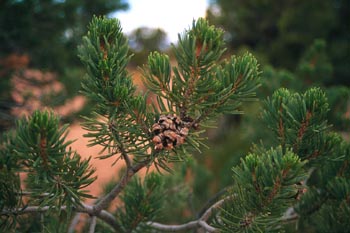Pinyon Pine

Common Name(s):
Twoneedle Pinyon
Singleleaf Pinyon
Pinyon Pine
Scientific Name:
Two Species:
Pinus edulis Engelm. (Twoneedle Pinyon)
Pinus monophylla Torr. and Frem. (Singleleaf Pinyon)
Scientific Name Synonyms:
None known
Symbol:
PIED (Twoneedle Pinyon)
PIMO (Singleaf Pinyon)
Description:
Life Span: Perennial
Origin: Native
Season: Evergreen
Growth Characteristics: Pinyon pine is a 10 to 30 foot tall tree, growing in a pyramidal or spreading shape. It reproduces from seeds.
Flowers/Inflorescence: Cones. Unisexual, in clusters at the ends of branches. The male cones occurring in clusters of 20 to 40, dark red to purplish red to yellow. Female cones are solitary and purplish. Mature female cones appear as "pine cones", light brown to tan in color with thick scales. The cones don't mature until September of the second year.
Fruits/Seeds: Seeds are pine nuts.
Leaves: 1 to 2 inch long needles, in spirally-arranged fascicles. There are 2 needles per fascicle in P. edulis, and 1 needle per fascicle in P. monophylla. New growth is bluish-green turning yellowish-green.
Stems: Twigs are smooth when young. Branches are rough and scaly. The bark is thin, gray to reddish-brown or nearly black. The trunk is frequently twisted and crooked. The bark is irregularly furrowed with small scales. Pine gum resin abundant.
Ecological Adaptions:
The woodland mosaic formed by pinyon pine occurs primarily on the high plains, plateaus, mesas, canyons, foothills, and lower mountain slopes of the Colorado Plateau. Sites are intermediate between ponderosa pine and submontane scrub above, and semiarid grassland or sagebrush steppe below. In the Great Basin, P. edulis is replaced by P. monophylla. Pinyon occurs most commonly at elevations between 4,500 and 7,500 feet where annual precipitation ranges from 12 to 18 inches.
The distribution of pinyon pine is primarily a function of climate. Its lower limits are determined by lack of moisture; upper limits by biotic competition, low temperatures, and excessive soil moisture. Therefore, the elevational zones it occupies vary considerably depending on local topography and geographical location. Pinyon pine usually grows on the higher elevation sites in the pinyon-juniper woodlands it occupies.
Soils: Dry and rocky soils.
Associated Species: Utah juniper, big sagebrush, Indian ricegrass.
Uses and Management:
Pinyon pine is worthless as forage for livestock. Although not preferred, cattle will use pinyon needles. Pinyon needles are believed to cause abortion in cows. The seeds are important wildlife food for several songbirds, quails, squirrels, chipmunks, black bears, and mule deer.
The seed crop of pinyon pine is valuable and is used in making candies, cakes, and cookies. The seeds were a staple food in American Indian diets and were eaten raw, roasted, or ground into flour. Seed crops are erratic, depending on moisture, and Indian migrations were determined by location of seed crops. Needles were steeped for tea. The inner bark served as starvation food for American Indians.
Today incense is made from crushed cones. Indians still use the pitch as a caulking compound for watertight baskets and as glue for turquoise jewelry. The annual harvest of pinyon nuts exceeds 1million pounds. This crop is second in commercial value only to pecans among the uncultivated nuts of the United States. Singleleaf Pinyon Pine (P. monophylla) nuts are larger and more desirable than those from P. edulis.
The tree is also desired as a Christmas tree because of its aromatic fragrance, and the wood is used for fuel and fence posts.

